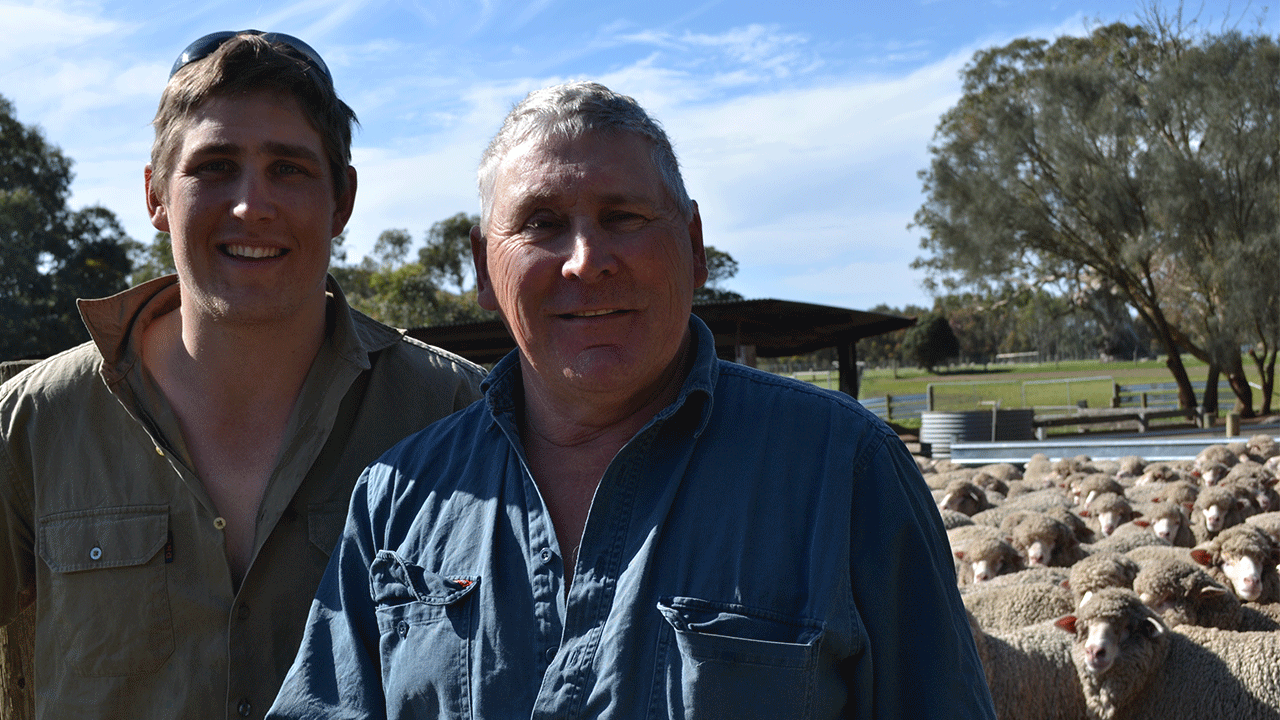
Ricky and Russell Luhrs
Ricky and Russell Luhrs
Victorian sheep and wool producer Ricky Luhrs has come a long way in eight years.
Victorian sheep and wool producer Ricky Luhrs has come a long way in eight years.
From the new kid on the block in the family business to progressive producer embracing genetic technologies and best practice, Ricky’s inquiring mind has driven gains in flock performance and profit.
Early on Ricky, who runs the property with help from his father, Russell, focused on how to cope with challenging seasons, particularly poor springs and late breaks, and how to improve lamb weaning percentages.
Responding to seasonal challenges
“Our approach has been a mixture of improved genetic selection and adopting management strategies to better utilise pasture and preserve ground cover,” he said.
“Containment feeding of all our sheep during late summer-autumn each year helps preserve pasture and build a winter feed wedge for lambing.
“The challenge is early assessment of the stock we want to carry over, and having enough supplementary feed and cash flow to get through the containment feeding period to ensure ewes are kept in good condition from joining right through.”
Genetics has also played a significant role, enabling Ricky to increase lambing percentages, lamb growth and carcase and fleece weights.
“By selecting rams based on Australian sheep breeding values (ASBVs), we’ve worked on getting more fat and muscle into our ewes so they have more of a fuel tank on their back for tough times which has, in turn, helped lamb survival,” Ricky said.
Chosen traits
Today, their operation is focused on improving their rate of genetic gain, particularly in traits for early growth (YWT* and PWT*), fat and muscle (PFAT* and PEMD*), fleece weight (YCFW*) and plain bodies (YSL* working with YCFW* – to prevent mulesing and working towards six-month shearing).
This, combined with improved breeder and ram management, has catapulted their operation into becoming more efficient, profitable and sustainable.
“Genetic selection is an important tool, but one of many on the farm, they complement each other,” Ricky said.
“The important management strategies that help us make the most of our flock’s genetic potential are early weaning, condition-scoring ewes at weaning to ensure they get back up to target weights, pregnancy testing, foetal ageing, good nutritional management of twins and singles, not shearing within six weeks of joining and good ram nutrition.”
Genetic first steps
Ricky first learnt about genetics and sire selection through Australian Wool Innovation’s Lifetime Ewe Management and MLA’s Bred Well Fed Well programs, and by attending a Best Wool Best Lamb Conference.
“I really enjoyed the learning curve,” he said.
“It was a great way of combining my youthful enthusiasm for wanting results with Dad’s (Russell Luhrs’) knowledge and passion for Merino sheep. We had the same breeding objectives so it worked well.”
Ram buying strategies
Ricky said interpreting ASBVs in a sale catalogue was easy, but he found it more challenging to understand the balance and heritability of traits “so you don’t end up single-trait heavy.”
To convince themselves that buying rams with ASBVs improved their flock, father and son set about designing their own on-farm trial.
“We bought rams from performance recorded studs, new to us but high on our radar for traits we wanted, and measured raw data on all the progeny from the different bloodline groups,” Ricky said.
“We measured early growth (marking to weaning), fleece weight at first full fleece shearing and the percentage that joined as ewe lambs.”
The new bloodlines, selected using ASBVs, outshone their traditional bloodlines in average growth rate, marking weight, weaning weight, fleece weight and lamb survival.